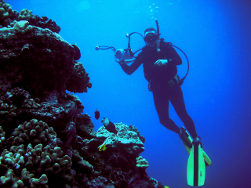
By its very nature, SCUBA diving imposes a lot of limits on those of us who choose to explore underwater. From the ascent rate to bottom times, everything we do in diving has some associated limit. One of those is the recreation diving depth of 130 feet. But, why 130 feet? Why not 140, or 126.7?
The answer primarily deals two factors; nitrogen narcosis and no-decompression limits. At 130 feet, nitrogen reaches a high enough partial pressure to cause a noticeable narcotic effect in most divers. Also called Martini’s Law and Rapture of the Deep, nitrogen narcosis tends to vary among individual divers and under differing levels of stress and other factors. One contributing factor is the level of CO2 present in the diver’s tissues, but that’s a topic for another day.
Also at 130 feet, the no-decompression or no-stop limit is around 10 minutes depending on what source you use to find it. In truth, decompression (and no-decompression) calculations are based on theory and experimentation. 10 minutes provides a reasonable bottom time with enough latitude to account for varying susceptibility among individual divers.
Also, as you descend, your air consumption rate increases to several times what you would use at the surface. At 33FSW, a diver’s air consumption rate doubles. For practical purposes, that reduces your air supply by half. Now take that down three more atmospheres. At 130 feet, your gas volume will be a 1/5 of what it was at the surface, leaving very little margin for error should something go wrong.


thanks for a information…